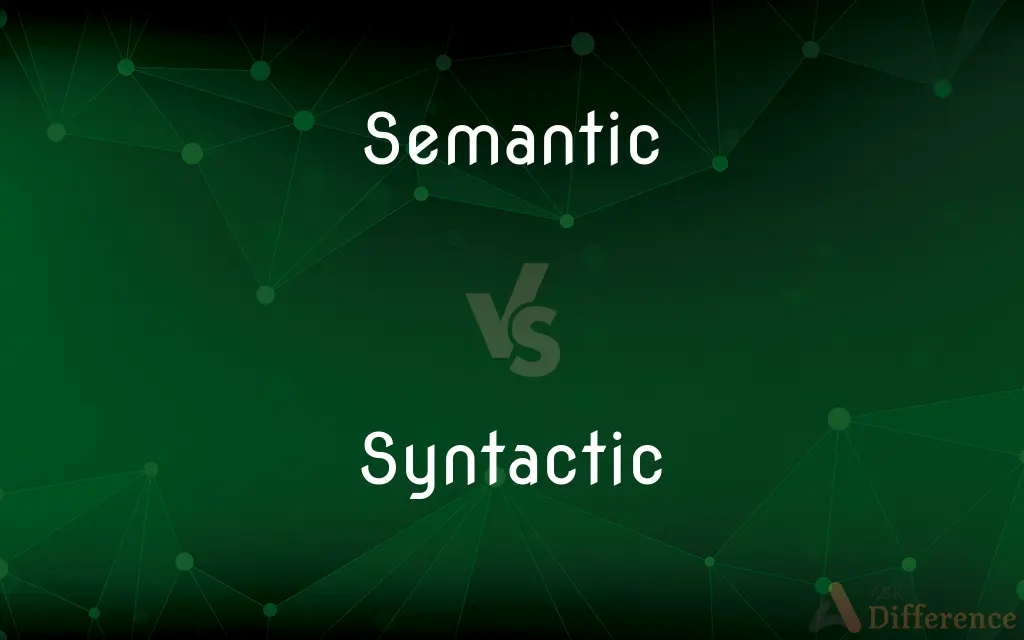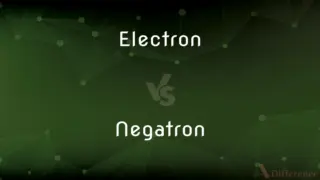Semantic vs. Syntactic — What's the Difference?
By Maham Liaqat & Fiza Rafique — Updated on May 16, 2024
Semantic refers to the meaning or interpretation of words and sentences, while syntactic pertains to the rules and structure governing the arrangement of words in sentences.

Difference Between Semantic and Syntactic
Table of Contents
ADVERTISEMENT
Key Differences
Semantic analysis focuses on understanding and interpreting the meaning conveyed by words, phrases, sentences, or texts. It deals with the relationships between signifiers, like words and phrases, and what they stand for or refer to. Syntactic analysis, on the other hand, examines the rules and patterns for constructing grammatically correct sentences. It involves the arrangement of words and phrases to create well-formed sentences according to a language's grammar.
Semantic concerns the meaning behind the sentence's structure. For example, "He saw her duck" can mean he saw her lower her body or her pet duck, depending on the context. In contrast, syntactic is about the grammatical structure itself, ensuring that elements like subjects, verbs, and objects are in the correct order to form a coherent sentence.
While semantic errors occur when the intended meaning is misunderstood or unclear, syntactic errors involve incorrect grammar or sentence structure. For example, "She happy is" is syntactically incorrect, while "She saw the bank" can be semantically ambiguous.
Semantic analysis helps in tasks like understanding text meaning, sentiment analysis, and language translation. Syntactic analysis aids in parsing sentences, grammar checking, and natural language processing tasks.
Comparison Chart
Focus
Meaning and interpretation
Rules and structure
ADVERTISEMENT
Concern
Relationships between words and meanings
Arrangement of words in sentences
Example
"Bank" can mean a financial institution or river side
"The cat sat on the mat" (subject-verb-object)
Error Type
Ambiguity or misinterpretation of meaning
Incorrect grammar or structure
Application
Text meaning, sentiment analysis
Parsing, grammar checking
Importance
Ensures correct interpretation
Ensures grammatical correctness
Ambiguity
Can arise due to multiple meanings
Less common, more about structure
Compare with Definitions
Semantic
Essential for accurate communication and understanding.
Semantic clarity is crucial in legal documents to avoid misinterpretation.
Syntactic
Governed by grammatical rules of a language.
Syntactic rules dictate that She runs quickly is correct, but She quickly runs can also be correct depending on emphasis.
Semantic
Deals with relationships between signifiers and their meanings.
The semantic analysis of bright star depends on whether it refers to an actual star or a famous person.
Syntactic
Focuses on sentence structure and word order.
The syntactic structure of He is happy follows subject-verb-complement order.
Semantic
Involves interpretation of context.
Understanding the semantic meaning of He saw the bat requires knowing if it's an animal or a sports equipment.
Syntactic
Ensures sentences are well-formed and coherent.
Happy he is is a syntactic error in English.
Semantic
Of or relating to meaning, especially meaning in language.
Syntactic
Relating to the arrangement of words and phrases.
In English, the syntactic order The boy kicked the ball is correct.
Semantic
Of, relating to, or according to the science of semantics.
Syntactic
Crucial for understanding the grammatical relationships between words.
Syntactic analysis helps in parsing sentences for natural language processing.
Semantic
Of or relating to semantics or the meanings of words.
Syntactic
Of, relating to, or conforming to the rules of syntax.
Semantic
Reflecting intended structure and meaning.
Syntactic
Of, related to or connected with syntax.
The sentence “I saw he” contains a syntactic mistake.
Semantic
Petty or trivial; (of a person or statement) quibbling, niggling.
Syntactic
Containing morphemes that are combined in the same order as they would be if they were separate words e.g. greenfinch
Semantic
(linguistics) In such writing systems as the Chinese writing system, the portion of a phono-semantic character that provides an indication of its meaning; contrasted with phonetic.
Syntactic
Of or pertaining to syntax; according to the rules of syntax, or construction.
Semantic
Pertaining to the meanings of words.
Syntactic
Of or relating to or conforming to the rules of syntax;
The syntactic rules of a language
Semantic
Of or pertaining to semantics.
Semantic
Of or relating to the study of meaning and changes of meaning;
Semantic analysis
Semantic
Pertaining to the meaning of words and sentences.
The word spring has different semantic meanings, like a season or a coil.
Semantic
Concerned with the nuances of meaning in language.
The semantic difference between child and kid can imply different levels of formality.
Common Curiosities
What is a syntactic error?
A syntactic error involves incorrect grammar or structure, like "She happy is."
What is a semantic error?
A semantic error occurs when the meaning of a sentence is misunderstood or unclear, such as using "bank" without context.
Why is syntactic analysis important?
It ensures that sentences are grammatically correct and well-formed, aiding in clear communication.
Can a sentence be semantically correct but syntactically incorrect?
No, a sentence must be syntactically correct to convey its intended meaning properly.
What does syntactic analysis involve?
Syntactic analysis involves examining the structure and rules for arranging words in sentences.
How does semantic ambiguity occur?
Semantic ambiguity arises when a word or phrase has multiple meanings, like "bat" (animal or sports equipment).
What role does context play in semantics?
Context is crucial in semantics to determine the correct meaning of words and phrases.
Can a sentence be syntactically correct but semantically ambiguous?
Yes, a sentence can follow grammatical rules but have unclear meaning, like "He saw her duck."
What is semantic analysis?
Semantic analysis focuses on understanding and interpreting the meaning of words and sentences.
Can computers perform semantic analysis?
Yes, through natural language processing, computers can analyze and interpret the meaning of text.
Why is semantic analysis important?
It ensures that the intended meaning of text is accurately conveyed and understood.
What is an example of syntactic analysis in technology?
Grammar checkers use syntactic analysis to identify and correct grammatical errors in text.
How does syntactic analysis help in natural language processing (NLP)?
Syntactic analysis helps in parsing sentences and understanding the grammatical relationships between words in NLP tasks.
How do semantics affect language translation?
Accurate semantic analysis is essential for translating text to maintain the original meaning in another language.
How do syntactic rules vary across languages?
Different languages have unique syntactic rules, such as word order and sentence structure.
Share Your Discovery

Previous Comparison
Fae vs. Fairy
Next Comparison
Electron vs. NegatronAuthor Spotlight
Written by
Maham LiaqatCo-written by
Fiza RafiqueFiza Rafique is a skilled content writer at AskDifference.com, where she meticulously refines and enhances written pieces. Drawing from her vast editorial expertise, Fiza ensures clarity, accuracy, and precision in every article. Passionate about language, she continually seeks to elevate the quality of content for readers worldwide.
















































